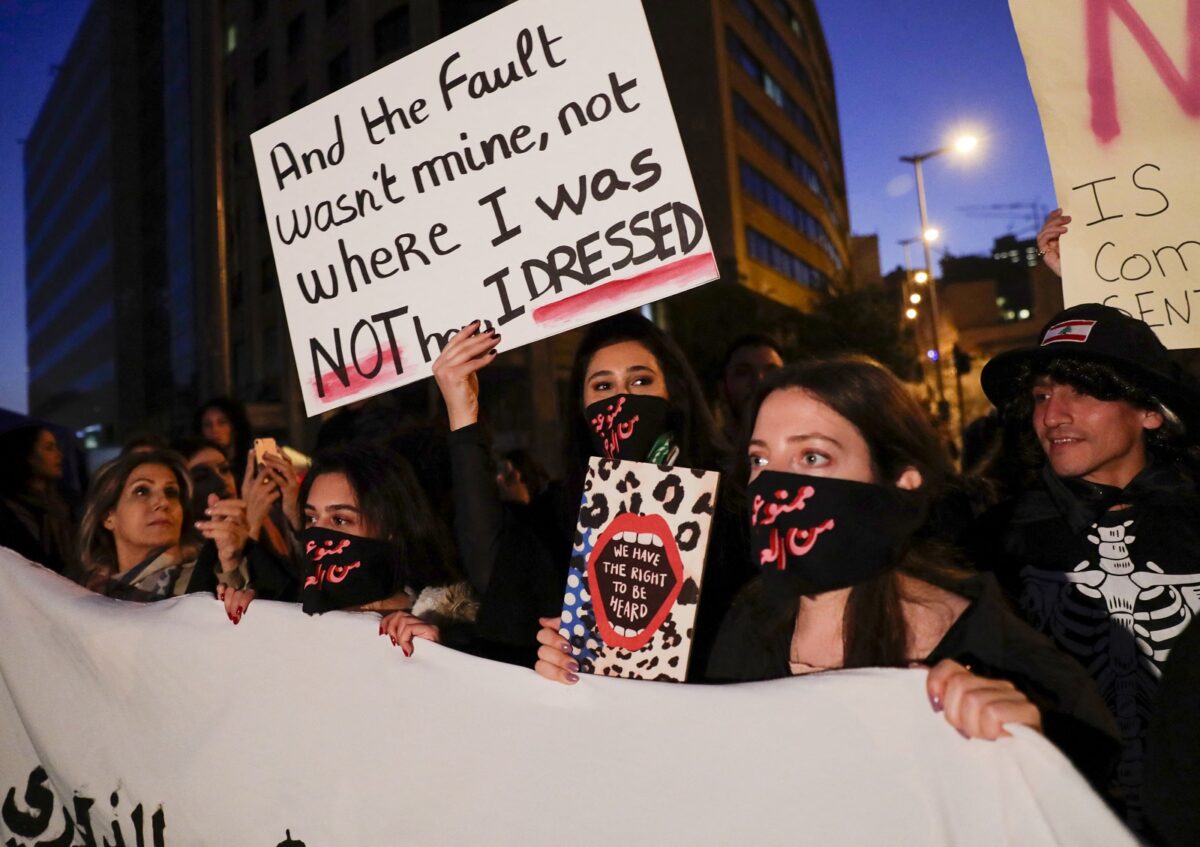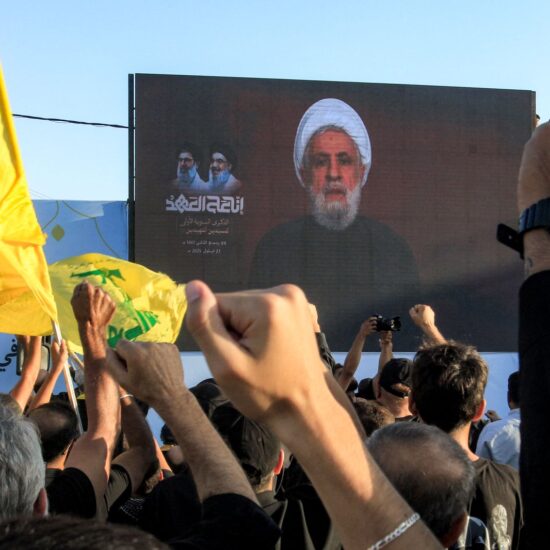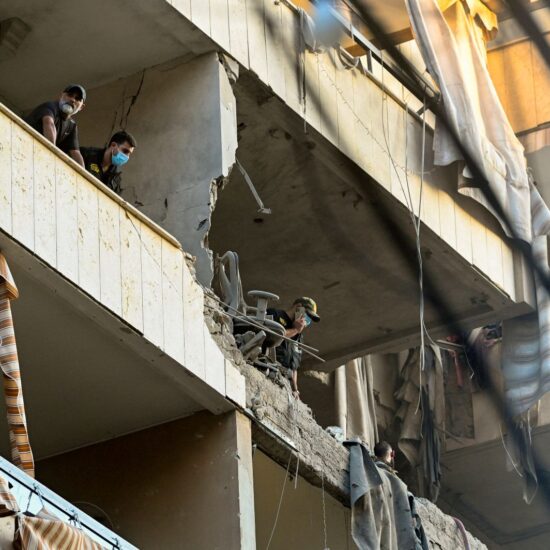
On sexual harassment and self-protection measures: how safety, for journalists, is a gender-based issue
She warns me: “I’m afraid you’ll be disappointed, it was just a tap on the thigh. Ten minutes long. While I was interviewing him.” Hannah, pseudonym of C., M., S., and many other women journalists – foreign and local – in Lebanon, told me about the unspoken risks of meeting a source, a man, usually in a position of power – an expert of politics, economics, history, or any other authority – for an interview: the undefined and often dangerous workplace for our category of professionals.
At home, in a café, online, in his office, even in a place of worship. When I firstly raised the question of sexual harassment suffered from a source – before, during or after an interview – to a group of journalists, I was told, with sarcasm: it would be a surprise to hear otherwise. So I started researching, collecting voices of women who, for the euphoria of an important meeting, the opportunity for a scoop, for the sense of duty towards their profession, or even just to prove to themselves that there is no difference compared to their male colleagues – out of a sense of justice and ideal equality -, have suffered comments, praise, jokes, explicit invitations to have sex, fondles, insults, aggressions. The reasons of the aggressors are outside the focus of this article: due to lack of interest, in the first place, as well as ethical responsibility to tell stories from the victims’ point of view – without blaming them, but recognizing their power to prevent and react to danger. And because of the necessity to talk about an important topic, too often ignored: doing it with knowledge of the facts, given that who is writing is included in the list of dotted initials grouped in the anonymity of a common name – Hannah.
With the aim – aware of the practical limits of a complaint to subvert a widespread system of prevarication and abuse -, of raising awareness on yet another risk of the journalistic profession, reflecting on the extended meaning of safety while reporting, beyond the helmet and the bulletproof press vest. As well as, hopefully, imagining other ways, from below, to protect ourselves without giving up the opportunity to investigate a topic of interest, meet influential personalities, liven up the network of contacts that in our work determine success, quality, and pleasure of reporting.
Hannah would never do it again
Hannah is Dutch, a freelancer, she had arrived in Lebanon a month before it happened. Her first article, the chance to come into contact with the Beiruti intelligentsia. The expert in question – a man, political scientist and artist – proposed to be interviewed at his place: it was the very first time they had met. “Obviously, if I could go back, I wouldn’t do it again,” she tells me before revealing the rest of the story. She had received his contact from a friend and colleague – a man – who had given her the green light: he, the friend, had also interviewed the other, the political scientist-artist and harasser, at home, one afternoon. He too had been offered wine, he too – out of courtesy – had accepted. “So I trusted him.”
What Hannah told me, however – common but not therefore acceptable – happened to her alone. The only difference: that of belonging to the second sex, as French writer, philosopher and feminist Simone de Beauvoir would have said.
“Maybe because I was new here, I mean, it surely was for that, because I had landed two months before, it was my first story on Lebanon, I was full of energy, but everything was new and I didn’t know a lot of people yet, a lot of Lebanese people, and I didn’t know the culture, so I felt it was normal for it to be a bit though. I told myself to just push back a bit, so I stayed and we drank and I tried to keep the interview going in the direction I wanted to, and not diverge into other things.”
The first sign – a verbal intrusion into her private life, the audacity to tease her with provocative questions, to irritate her, she says. Even though she was the one who had the notebook in her hands, with her list of questions, the professional mandate to conduct the interview.
“When it was finally done, he asked me to stay for another drink, just because we were still talking about other stuff, you know, and it was also interesting. I thought he’s a bit weird, but also very knowledgeable, and you don’t want to miss out. Then, in the back of your mind, there was also the thought: if I was a guy, it would have been completely fine, right? So why should I miss this opportunity? Keep the distance but stay here, I told myself.” And then, laughing with bitterness: “why should I miss out on interesting people, just because I am a woman?”.
The second sign – the insolence. “He began to be rude, it seemed he was having a bad hangover. He was also frustrated because I was not giving him the answers he wanted to. Or he just couldn’t get there. So he started commenting on me, my political opinions, my physical appearance, in a very unpleasant way, which didn’t feel comfortable at all, and I still stayed. At some point we had a bit of an argument, and he started to talk really weirdly. I thought he’s completely drunk, and when he got it back, he apologized, he said I’m so sorry but this sometimes happens when I drink, my speech starts to…I don’t even know. Still the situation was tense and I was trying to leave, I wonder why I didn’t do it immediately. Maybe I was trying to fix the relationship. To keep it professional.”
And then – the danger. “All of a sudden, I was sure he was out for something more, and when I tried to discuss that and say no, this is not where we should go, he started to tell me that he knew he wanted me there from the moment I got in, and that was because…he knew it was something in particular about me. At first he didn’t want to tell me.”
Hannah gets embarrassed. The sense of guilt she carries is evident: that of all the victims of sexual harassment and violence, of those who have never had the courage to talk about it to anyone.
“It just feels so ridiculous when I talk about it, but” – she hesitates – “I kind of wanted to know and also not, and he became so strange, and then he said it. ‘It’s because I smelled you when you came in.’ I was wearing a leather jacket and it was very warm, I had walked, so I sweated a bit, and he continued, ‘I smelled you.’ Have you ever read Lolita? He was talking about me, how I smelled, how I walked, what I wore, and he couldn’t stop thinking about it. And I felt harassed, obviously. It was very horrible.”
She doesn’t remember exactly how, but at some point she was so upset that she just went away. “It was too much, I had been there way too long. So I left. I realized I should not have gone there, or at least not stay so long – although my friend knew him well, and it seemed safe to be at his place: yet I could have stopped whenever I felt uncomfortable, of course. But it was surprising to realize that he, my friend, as a man, never thought about those things – how such a person might behave with a woman. It is such an important aspect to consider when we, as journalists, recommend each other’s sources.”
Since then, Hannah has had very few conversations about her experience. When she thought about it afterwards, on her own, it forced her to look at herself, about how much of what happened was due to her being careless or wanting to prove something, as a woman in this field – and then, considering how often it happens to other women, whether she should have behaved differently. As of today, she seems not to know yet.
“A lot of our work is also about relations, connections, getting to know people, but that is so personal that you always take a risk, especially with men, because there’s the other aspect of being very careful and clear of what you want, otherwise it might be interpreted differently. And that’s always tricky. It starts as a curiosity for colorful people, for an interesting context you want to keep being part of here in Lebanon, and you don’t want to miss an opportunity because you are a woman. But at the end it seemed more about how a toxic relationship works than an actual professional risk.”
The news was worth the risk
The margin of action we have, as women journalists, in this relation with our sources, the never-ending negotiation, the constant follow-up on a topic of interest, is linked to the gender of our interviewees. Sarah Stillman, staff writer for The New Yorker, once said that what’s really heartbreaking about this gap are the times when you feel it is shaping and informing the kinds of stories that you can tell, or that you feel you can’t tell simply because you don’t want to take the risk of going into a scenario that feels really uncomfortable. So there are times when you do give up an incredibly critical source because they’ve been insistently, consistently sexualizing you, not listening to the messages you’re clearly articulating, that you need them to stop. Another Hannah, Italian – the one who is writing this piece – is sure she has left many contexts down because of this risk.
But Hannah is also French, and if she had the need to meet her harasser again – a need related to a piece to write – she would have. About my way of cutting off with the source, she thinks that it’s probably not fair, as it makes everybody guilty, and prevents me from accessing many useful contexts. “This happens to me a lot,” she says, “not necessarily in journalism. But I refuse to change the way I am. I will not start to act mean just because men are like that. It’s their responsibility to change their behaviour. That said, it is also my job to say something about it, and I feel I would do it now, I would not accept to feel uncomfortable again, as I did that time.”
“It was during an interview. I was working on a religious minority group in Lebanon. The head of the community – who never wants to speak with journalists – addressed me to another member, whom I had seen already before. I met him at the site of their sanctuary, not far from Downtown. It was a once in a lifetime opportunity. I actually entered the shrine, which you usually don’t have access to, and it was great.” She warns me, almost afraid to disappoint my expectations. “What happened to me wasn’t that big of a deal, I mean we always say that.”
While I listen to Hannah speaking, telling me about what she faced with the sense of humor that always comes with the deep awareness of oneself, I can almost hear the voice of Jina Moore, East Africa bureau chief of The New York Times, whom I once heard saying that every brilliant woman, and every brilliant female reporter she knows, has spent too much of their lives second-guessing their first feeling about whether this is a big deal or not. Her answer: as soon as the question enters your head, it’s a big deal. And the time you spend litigating it is time you were distracted from figuring out how to deal with what your system, whether your brain has caught up or not, has identified as a risk. And so it happened.
“We were sitting in the office right next to the sanctuary, on a little couch, I was on the side, and he was next to me, and then started to get closer and closer, until he began to touch my tight up and down. He wasn’t even saying anything sexual, he was just like ‘oh so interesting, tell me about yourself…’ and that lasted a while. Like a solid ten, fifteen minutes. Because I had, I wanted to finish my questions. Plus there was no signal, which freaked me out for a moment.”
“It made the interview longer, which is annoying, and then I got out of there feeling I needed to shower” – she laughs, with seeming carelessness. She uses the word ‘annoying’ – minimizing the experience she faced – although if something like that happened to her now, she would probably react differently. Say something, at least. “I didn’t say anything because that was such a major opportunity. The article I did, no one had done it before. So I was just like ‘suck it up, finish the interview, and leave’.”
I ask her if she learned any lessons from there, if there are things she stopped doing in her profession. “That goes beyond journalism, it is just women’s behaviour,” she answers. “You don’t go to a guy’s place if you don’t know him, especially if it is professional. And you would always refuse certain things. But again, it is not related to journalism.”
In Lebanon
Generally, sexual harassment in the workplace can take on many forms, greatly impacting performance and increasing absenteeism and employee turnover. In the specific context of journalism, this can lead to more limited access to sources or news, threatening the opportunity to cover a topic, and therefore to work. Only because the professionals’ gender is ‘the second.’
Globally, women are more at risk to be victims of sexual harassment than men – as according to the International Labor Organization (ILO) and Human Rights Watch (HRW). Many victims, however, are unaware that they have been subject to sexual harassment, discouraged by the absence of laws in many countries which criminalize it – as well as methods of reporting that are deemed risky for victims to seek support.
Based on the ILO, sexual harassment is defined as “a sex-based behavior that is unwelcome and offensive to its recipient,” and it exists in two forms: the first is related to job benefits, whereby promotions, pay increases or job security are linked to different forms of forced or suggested engagement in sexual behavior; while the second is based on intimidation or humiliation of the victim, creating an uncomfortable workplace setting. As a report released by the American University of Beirut (AUB) in 2021 showed, there are three different acknowledged sexual harassment behaviors: the physical, which could mean that the perpetrator is not respecting a comfortable social space or is touching or abusing the victim; the verbal, tied to any comments related to a person’s physical appearance, sexual orientation, or personal matters that the victim is not comfortable sharing; and the non-verbal sexual harassment, which could take on many forms, through visual elements, sexually suggestive signals, or even sounds.
Specifically in the workplace, moreover. very few laws are set to protect victims of sexual harassment in Lebanon. However, after years of lobbying and activism, a regulation was set – yet far from being perfect. In December 2020, the Lebanese Parliament passed a law, the Anti-Sexual Harassment Law No. 205, making sexual harassment a crime and protecting the Lebanese employees from gender-based violence, not just in the workplace, but everywhere. With the passing of the law, perpetrators could spend up to four years in prison and pay hefty fines – up to 50 times the minimum wage – if they violate the code. Furthermore, it guarantees the victim’s right to claim compensation for the moral damages incurred, as well as the protection of the victim and of witnesses from any discrimination they might face in the workplace.
Punishing offenders according not only to the degree of vulnerability of the victim, but also to the offender’s social role, the law takes into consideration the dynamics of power and authority in social relation, providing varying degrees of punishment based on the crime and the perpetrator’s status: the higher the position of the offender, the harsher the punishment. After all, when we talk about sexual harassment or sexual violence against women, it’s hardly ever about the sex – but about power: the one exerted, by men, over women.
Let’s talk
“I wrote the article at the end. The stupid thing was that I used a quote from what he said, I just thought he described it very well, but I should not have given him the award.”
“Afterwards he texted me a couple of times, he was very very sorry, and I just ignored it, and after the third time he said ok, once again I’m sorry, I just wanted to get to know you, but if this is it I won’t bother you again, so it stopped like this.”
“I haven’t come across him anymore, so I don’t know if other journalists had the same experience. Now I think this is something women should know. I wish there was a platform to share these kinds of experiences.”
“There’s something I later learned in a HEFAT (Hostile Environment First Aid Training) course, that I wish I had known back then, which is to remind everybody of their role. I’m here for this. Just reminding the person this is why I am here, this is what you’re expected to do, which is answering my questions. Sort of a verbal contract.”
With these and other statements, awareness and regrets, Hannah responded to my stimulus for reflection on prevention: given an imperfect and rarely enforced legal system, along with a general patriarchal social context, how to avoid – or at least partially reduce – the risk of sexual harassment suffered while reporting. Certainly not to blame the victim: but to make them – to make us – responsible with respect to parallel and pragmatic methods to unmask and combat an overly widespread practice.
When covering a war zone, press vests and bulletproof helmets do not serve the intent of blaming the journalists in the spot of fire attacks for the irresponsibility of being at the frontlines. Being on the ground is their profession. The armies are those responsible for the attacks – and the enemy armies those for the deliberate target against reporters. This does not undermine the need to be on the field. It does not shake the professional vocation of war journalists.
Our real question, still open, therefore is: what could be the bulletproof vest for countless female journalists exposed to the risk of sexual harassment. The members of the Dart Center for Journalism and Trauma, a project of Columbia Journalism School, tried to answer. In October 2017, following the murder of Swedish freelance reporter Kim Wall and the sweeping #MeToo reckoning with sexual harassment, the Dart Center asked nine leading women in journalism – Christiane Amanpour, June Cross, Marcela Gaviria, May Jeong, Azmat Khan, Judith Matloff, Jina Moore, Alexis Okeowo and Sarah Stillman – to talk about the impact of the challenges of harassment and the threats of gender-based violence on their work, and to reflect on their own best practices. The 12-minute video is the result.
In addition, under the title ‘Let’s Talk: Personal Boundaries, Safety & Women in Journalism’ they produced a tip sheet offering strategies for recognizing, mitigating and addressing sexual harassment and other predatory behavior while reporting. Albeit not exhaustive nor substitutable for discussing challenging situations with colleagues, still the sheet provides useful tips and insights: from choosing safe meeting places, avoiding being alone with any individual we don’t know or trust, to alerting friends and colleagues, by using location-tracking mobile apps.
In the specific context of sexual harassment acted by a source, moreover, the strategies that some of the interviewed journalists have used are sensitive to the kind of harassment faced, as well as to what the victim is comfortable saying and doing, and how much she needs a particular source. In all cases, the suggestion is to trust your instincts: there’s no right or wrong approach. Here some examples:
Be direct: Keep phrases of this kind in mind: “I appreciate you agreeing to be interviewed, but I’m not comfortable with [describe the offensive behaviour], so please stop.” Or go for the simpler “I want to be clear: I’m here only to report on this story.” If you want one line to remember that could apply in many situations, consider: “That’s not going to work for me.” If he’s moving too close to you, put your hand up and say: “Please don’t crowd me.” If the harassment is more insistent, give a simple, determined, “No” or “Cut it out.” Whatever you say, once you’ve succinctly made your point, move right back to the interview, so the conversation doesn’t become a debate about the concerning behaviour.
Be indirect: Some journalists worry that being direct will rule the source, making the situation increasingly tense or potentially dangerous. They opt for deflection, like referencing a husband or boyfriend (even if none exists), and are both relieved and infuriated when that works. Others try a nonverbal approach, like smiling less or moving a bit farther away.
Ignore the behaviour: Some journalists, when harassed but not endangered, choose to act as if they never heard the comment. Some men, after noticing their efforts are being ignored, give up – if not the first time, then soon after. Important: If the situation feels dangerous, ignoring it altogether is not the right response.
Be unyielding: If a source or colleague touches you in any unwanted way, such as a hand on your shoulder or knee, don’t freeze: instead brush the hand away and continue professionally if it feels safe to do so. If you’re being followed, turn and look directly at the person, even point at them and say in a deep, loud voice, “Can I help you?” or “Stop following me!” This may throw off the harasser, and get them to leave you alone.
Try humour: Some journalists use humour in response to sexist or sexualized words/behaviour, figuring it avoids confrontation but shows a line has been crossed. Just be mindful that your humour isn’t taken as a flirty rebuttal.
Cut the interview short: If you feel endangered or uncomfortable enough that you want out, get out. You can be blunt about why you’re leaving, or you can find an excuse: You have a headache, you have to meet someone else, etc. You also can always end an interview by calmly and professionally stating, “We have to stop now.”
Moreover, if you’ve experienced harassment but decide you need to maintain the source, the tip sheet suggests to either email him, typically more effective than talking, as you’d have written proof of the exchange – should you ever need it, or ask an intermediary, in case you’re not comfortable addressing the harasser directly. Instead, if you are unconcerned about maintaining your contact with the source, you could either drop the source – even if he’s articulate and plugged-in – or ultimately report him, especially if your source is speaking as a company or government official or employee.
In all cases, avoiding chances of reporting – even if risky – is not the way to protect us. What Alexis Okeowo, staff writer for The New Yorker and interviewed by Kerry Donahue, would tell young female journalists about this issue, is that “despite the fact that women are vulnerable in this world, they shouldn’t be afraid. They should still go out and write. That’s still the best way, to go out in this world and find stories, and tell them.”
What has been a great support network for her is having female journalist friends who she can talk to and ask for advice, comparing notes and looking out for each other. Eventually we, women, keep learning ways to protect ourselves more, but how much, Okeowo wonders, how much self-protection do we need to learn before we address what is causing us to feel afraid or feel nervous or feel like we’re not safe?
“And I think” she continues, “that for women who are out on their own, whether it’s freelancing or doing an assignment in the field, I think that editors can be aware this happens and be a receptive ear to it, being able to listen to the troubles a woman might be having in the field with her sources, with her fixer, and not use that as an excuse not to send a woman out into the field, but actually be a resource, be someone she can call or rely on if she’s in a tricky situation.” Even from male editors’ perspectives, therefore, the fact that women face particular challenges should not be a reason not to give them opportunities.








